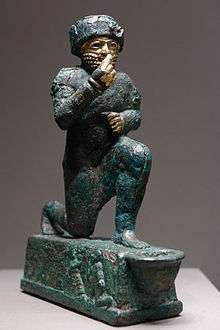Amurru (god)
Amurru and Martu are names given in Akkadian and Sumerian texts to the god of the Amorite/Amurru people, often forming part of personal names. He is sometimes called Ilu Amurru (DMAR.TU). He was the patron god of the Mesopotamian city of Ninab, whose exact location is unknown. He was occasionally called "lord of the steppe" or "lord of the mountain".[1]

| Part of a series on |
| Ancient Mesopotamian religion |
|---|
 Chaos Monster and Sun God |
|
Seven gods who decree
|
|
Other major deities |
|
Demigods and heroes
|
| Related topics |
Description
Amurru/Martu was probably a western Semitic god originally. He is sometimes described as a 'shepherd' or as a storm god, and as a son of the sky-god Anu. He is sometimes called bêlu šadī or bêl šadê, 'lord of the mountain'; dúr-hur-sag-gá sikil-a-ke, 'He who dwells on the pure mountain'; and kur-za-gan ti-[la], 'who inhabits the shining mountain'. In Cappadocian Zinčirli inscriptions he is called ì-li a-bi-a, 'the god of my father'.[2]
Accordingly, it has been suggested by L. R. Bailey (1968) and Jean Ouelette (1969), that this Bêl Šadê might be the same as the Biblical ’Ēl Šaddāi who is the God of Abraham, Isaac, and Jacob in the "Priestly source" of narrative, according to the documentary hypothesis. Bêl Šadê could also have become the fertility-god 'Ba'al', possibly adopted by the Canaanites, a rival and enemy of the Hebrew God YHWH, and famously combatted by the Hebrew prophet Elijah.
Amurru also has storm-god features. Like Adad, Amurru bears the epithet ramān 'thunderer', and he is even called bāriqu 'hurler of the thunderbolt' and Adad ša a-bu-be 'Adad of the deluge'. Yet his iconography is distinct from that of Adad, and he sometimes appears alongside Adad with a baton of power or throwstick, while Adad bears a conventional thunderbolt.
Wife
Amurru's wife is usually the goddess Ašratum (see Asherah) who in northwest Semitic tradition and Hittite tradition appears as wife of the god El which suggests that Amurru may indeed have been a variation of that god. If Amurru was identical with Ēl, it would explain why so few Amorite names are compounded with the name Amurru, but so many are compounded with Il; that is, with El.
Another tradition about Amurru's wife (or one of Amurru's wives) gives her name as Belit-Sheri, 'Lady of the Desert'.
A third tradition appears in a Sumerian poem in pastoral style, which relates how the god Martu came to marry Adg̃ar-kidug the daughter of the god Numushda of the city of Inab. It contains a speech expressing urbanite Sumerian disgust at uncivilized, nomadic Amurru life which Adg̃ar-kidug ignores, responding only: "I will marry Martu!".
References and external links
- Paul-Alain Beaulieu, The God Amurru as Emblem of Ethnic and Cultural Identity in "Ethnicity in Ancient Mesopotamia" (W. van Soldt, R. Kalvelagen, and D. Katz, eds.) Papers Read at the 48th Rencontre Assyriologique Internationale, Leiden, July 1–4, 2002 (PIHANS 102; Nederlands Instituut voor her Nabije Oosten, 2005) 31-46
- The Targum from the Beginnings: "Tablet 1." Retrieved on September 12, 2010
| Wikimedia Commons has media related to Amurru (god). |
- Bailey, L. R. (1968). "Israelite ’Ēl šadday and Amorite Bêl šadê", Journal of Biblical Literature 87, 434–38.
- Cross, Frank Moore (1973). Canaanite Myth and Hebrew Epic, pp. 10, 57–58. Cambridge, Massachusetts: Harvard University Press. ISBN 0-674-09176-0.
- Jordan, Michael. Encyclopedia of Gods, Kyle Cathie Limited, 2002
- Ouellette, Jean (1969). "More on ’Ēl Šadday and Bêl Šadê", Journal of Biblical Literature 88, 470f.
- ETSCL: Narratives featuring deities: Other deities, including "The Marriage of Martu" in Unicode and ASCII.
- Iconography of Amurru (PDF-article)